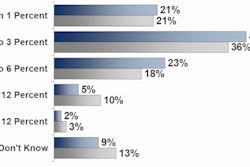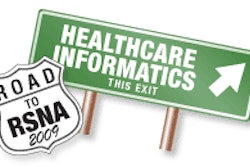CHICAGO - As healthcare information technology approaches the second decade of the 21st century, radiologists can expect to have the opportunity to access data that supplement their own knowledge, enabling them to make more educated, and presumably better, diagnoses.
Just as PACS and portable digital media such as DICOM CDs have made possible immediate access to a patient's entire imaging file, clinical data acquired from electronic medical records, sliced and diced by sophisticated analytic software, have the potential to make as yet impossible access to clinical records, cumulative imaging procedure diagnoses of hundreds or thousands of patients, and pertinent peer-review knowledge feasible.
Dr. Christopher Sistrom, chief information officer and associate department chairman at the University of Florida Health Center in Gainesville, opened what in future years may be viewed as an RSNA session on the elementary utilization of data to provide clinical decision support, with a look at how "big data" may be used to support radiology diagnoses and intelligent management of diagnostic imaging resources.
"Science is basically trying to observe, classify, explain, and control the natural world. Our natural world is patients," Sistrom said. He pointed out that access to data, using software to provide both a comprehensive clinical record of a patient as well as the clinical context of the patient in conjunction with the entire patient population of healthcare facilities providing treatment, will present inductive stimuli to the radiologist reading an exam and supplement his collective memory of similar images and the diagnoses made from them.
"Disasters like 9/11 and Hurricane Katrina revealed that smaller organization units with clearly defined missions and tight command structures deal more effectively with crises than larger entities," Sistrom said.
"Coordination should allow lower ranking people to make independent judgments and have situational awareness. In medicine, there is a common conceit that data analysis should be limited to statisticians working in an academic environment," Sistrom told AuntMinnie.com in a related interview. "Data should be democratized and every physician should have access to reality."
"Medical data requires an infrastructure: comprehensive data, software to analyze and extrapolate from it, and real-time access to make prompt decisions," he emphasized.
"Big data" isn't readily available yet, but some pioneering initiatives that mine data to offer decision support are being utilized at Massachusetts General Hospital (MGH) and the Lifespan network of three hospitals affiliated with Brown University in Providence, RI.
CT exam alert in Rhode Island
When a healthcare enterprise consists of multiple, geographically dispersed hospitals, physicians may not be aware of the diagnostic procedures performed. To make physicians aware of prior CT exams, the Rhode Island Hospital in Providence, the Miriam Hospital in North Providence, and the Newport Hospital in Newport use an electronic notification software program that interrogates the hospital network radiology database to determine the number of prior CT exams a patient may have had.
If a physician orders a CT exam for a patient who is younger than 50 years and has had five or more CT exams, an alert is displayed within seven seconds. In side-by-side format, the entire history of CT exams since 2001 are displayed, as well as the exams performed in the past twelve months.
"This alert makes a physician aware that a prior exam duplicating the one he or she is about to order is in the PACS, and also may encourage the ordering physician to contact a radiologist about an alternative exam that uses less radiation, Dr. William Mayo-Smith, director of CT of the Warren Alpert Medical School of Brown University, explained to the RSNA session attendees.
While each hospital maintains separate medical record numbers for patients who have diagnostic imaging procedures performed, each patient has a single, unique patient identification number, thus allowing for rapid search and consolidation of CT exam records in seven seconds or less. The software tabulates CT exams into brain, neck, chest, abdomen, pelvis, or extremity categories.
"We made an arbitrary decision with respect to using five CT exams and a cutoff age of 50, because if physicians see an alert too frequently, they will ignore it," Mayo-Smith said.
From January through April 10, 2009, 5,218 orders for CT exams were placed, and 654 alerts were generated. How many orders were cancelled as a result of this information? Unfortunately, that fact is unknown, as the software does not yet have the capability to capture follow-up data. The system also cannot alert physicians placing CT exam orders for outpatients; Mayo-Smith said that is needed.
Low-utility utilization software at MGH
In 2004, Massachusetts General Hospital in Boston implemented a decision-support system providing real-time feedback about the appropriateness of diagnostic imaging exams being ordered. The system, integrated with the hospital's Web-based radiology order entry system, was designed to advise the ordering physician of the level of appropriateness of the procedure using a simple utility score of one to nine.
The system had a positive impact, but low-utility exams were still being ordered, frequently by nonclinical support staff working for the referring physician. So in 2007, a simple change was implemented that restricted support staff from ordering exams that received scores indicating low utility -- these could only be authorized by the referring physician.
Dr. Vartan Vartanians, a radiology clinical research associate, presented the results of a before-and-after analysis of the effects of this ordering protocol change. Approximately 43,000 orders were placed that received a low utility score between April and December 2006, and approximately 76,000 were placed between April and December 2007.
Vartanians reported that clinicians who were placing the orders themselves cancelled 24.42% of the exams in 2006, before the change was implemented, compared to 38.50% in 2007. Either the orders or information related to the orders were modified 14.92% in 2006, and this did not change in 2007, at 14.63%. But the percentage of physicians who ordered the exam, knowing its low utility, dropped significantly, from 60.66% to 46.87%.
Preventing support staff from being able to order low utility exams without the referring physician's review and direct participation made a big difference. In 2006, 8.39% of the exams were cancelled. This dramatically increased to 57.32% in 2007. Modifications, either by ordering a different exam, but more often in providing additional clinical information that made a difference, increased from 9.99% in 2006 to 35.23% in 2007.
"A minimally disruptive alteration in the radiology order entry system can encourage this behavior, enhancing the effectiveness of decision support and decreasing the overall use of low-yield examinations," Vartanians said. He pointed out that the decision-support system also included recommendations of exams that would be more appropriate, and this was meant to educate ordering physicians as well as provide a recommendation based on outcomes data.
Lower cost was not an issue with respect to the exams being recommended, Vartanians said. No cost analysis has been performed using this data.
By Cynthia E. Keen
AuntMinnie.com staff writer
November 30, 2009
Related Reading
Radiologists recommend more follow-up imaging studies, November 18, 2009
Could decision-support software help radiologists fend off RBMs, April 7, 2009
Decision-support software cuts imaging procedure volume, March 24, 2009
Copyright © 2009 AuntMinnie.com



















